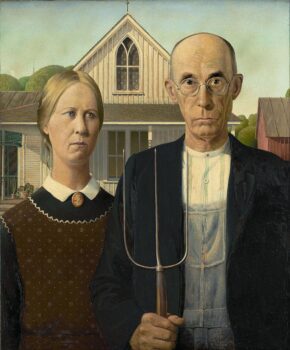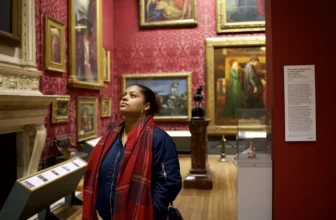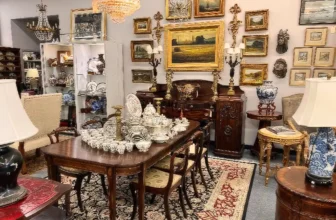American Gothic Painting by Grant Wood
An In-Depth Analysis of Its Meaning, Symbolism, and Enduring Legacy
One of the most recognizable and parodied paintings in American art history, American Gothic by Grant Wood has long captivated viewers with its stoic figures and haunting simplicity. Painted in 1930 during a period of intense cultural and economic change in the United States, American Gothic is more than a mere portrait; it is a complex tapestry of symbolism, historical commentary, and artistic expression. This article offers a comprehensive 2000-word exploration of the painting’s origins, artistic style, symbolism, interpretations, and its current location.
What Is American Gothic All About?
At first glance, American Gothic appears to be a straightforward depiction of rural life in the Midwest: a stern-looking man holding a pitchfork stands next to a woman, presumably his wife or daughter, in front of a farmhouse with a distinctive Gothic-style window. The figures are dressed in early 20th-century rural attire, and the setting evokes a sense of agrarian tradition. However, the painting’s simplicity belies its profound complexity.
Grant Wood created American Gothic during the Great Depression, a time when American society was wrestling with questions about identity, values, and resilience. The painting is often interpreted as a reflection on American character, its stoicism, conservatism, and work ethic. But its meaning is layered, and interpretations have varied widely depending on historical context, social perspective, and artistic analysis.
Who Painted American Gothic?
American Gothic was painted by Grant Wood, a prominent American painter born in 1891 in Anamosa, Iowa. Wood grew up in the rural Midwest, a region that profoundly influenced his artistic vision. Though he briefly studied art in Europe, where he was exposed to Impressionism and Post-Impressionism, he ultimately rejected these styles in favor of a more realist, regionalist approach.
Wood became one of the leading figures of the American Regionalism movement, which sought to celebrate everyday life in rural America. His work is characterized by meticulous detail, clarity of form, and a deep engagement with Midwestern themes. American Gothic remains his most famous and iconic work, securing his place in American art history.
The Inspiration Behind American Gothic
The inspiration for American Gothic came when Grant Wood saw a small white house in Eldon, Iowa, with a distinctive Gothic window. Wood was struck by the incongruity of the ornate architectural detail in such a humble, rural setting. He imagined the kind of people who might live in such a house and decided to paint a portrait that captured their essence.
For the models, Wood chose his sister, Nan Wood Graham, and his dentist, Dr. Byron McKeeby. Despite being unrelated in real life, they were posed as a farmer and his daughter (or wife, according to some interpretations), embodying the austere, moralistic spirit that Wood associated with rural America.
What Type of Art Is American Gothic?
American Gothic is considered a quintessential example of American Regionalism, an art movement that gained prominence in the 1930s. Regionalist artists sought to reject the abstract and cosmopolitan styles coming out of Europe, instead focusing on realistic depictions of everyday life in rural and small-town America. Their works often carried a tone of nostalgia and moral clarity, celebrating American values of hard work, self-reliance, and community.
In stylistic terms, American Gothic also exhibits elements of Realism, characterized by precise detail, lifelike representation, and an unembellished portrayal of its subjects. The sharpness of the features, the textured surfaces of the clothing, and the architectural precision all speak to Wood’s commitment to craftsmanship and truthfulness in representation.
Symbolism and Interpretation of American Gothic
The power of American Gothic lies in its rich symbolic content. Each element in the painting contributes to a layered reading that has kept art critics, historians, and the public engaged for decades.
The Gothic Window
The Gothic window in the farmhouse is one of the most striking architectural details in the painting. It alludes to the pointed arches of Gothic cathedrals, suggesting a sense of moral uprightness or religious piety. Yet, the juxtaposition of this high-style architecture in a modest rural setting introduces an element of irony. It speaks to the ambitions and contradictions of American life, a desire for refinement and tradition amid humble circumstances.
The Pitchfork
The pitchfork held by the man is not merely a tool; it is a symbol of labor, resilience, and perhaps even aggression or defensiveness. It echoes the vertical lines of the man’s overalls and the Gothic window behind him, creating visual unity but also reinforcing a sense of rigidity and severity.
The Figures
The man’s austere expression and formal posture suggest an adherence to discipline and authority. The woman’s sideways glance and clasped hands, meanwhile, have been interpreted in many ways: as submissive, contemplative, anxious, or even skeptical. Their expressions and body language communicate a dynamic that can be read as generational, gendered, or social commentary.
Some critics see the figures as a critique of rural conservatism, stiff, judgmental, and repressive. Others interpret them more sympathetically, as emblematic of the American spirit in the face of hardship. Grant Wood himself claimed that he painted them as honest, hardworking people, but the ambiguity of their expressions leaves room for interpretation.
Clothing and Accessories
The man’s overalls, partially covered by a formal jacket, and the woman’s apron with a colonial-style cameo suggest a blend of the old and the new, the practical and the traditional. These elements underline the theme of American identity rooted in both history and everyday toil.
What Is Happening in American Gothic?
While American Gothic does not depict an event or narrative in the traditional sense, it tells a powerful psychological and cultural story. The painting presents a frozen moment, a tableau that invites viewers to speculate on the relationship between the figures, their values, their lives, and their emotions.
Are they husband and wife, or father and daughter? Are they united or isolated? Are they proud or burdened? The lack of definitive answers compels viewers to engage deeply with the image, projecting their own interpretations onto the scene. In this way, the painting becomes a mirror reflecting the viewer’s assumptions about America, tradition, gender roles, and morality.
Controversy and Criticism
When American Gothic was first unveiled at the Art Institute of Chicago in 1930, it won third place in a contest and was immediately purchased by the museum. Yet, the reaction to the painting was far from unanimous.
Some Iowans were offended by what they saw as a caricature of rural life. They believed Wood had mocked the plainspoken dignity of Midwesterners, portraying them as joyless and rigid. Others, however, saw the painting as a tribute to the endurance and strength of rural Americans, especially during the hardships of the Great Depression.
Over time, American Gothic has been reinterpreted again and again, used in political cartoons, parodied in pop culture, and employed in advertising campaigns. Its very ambiguity has made it endlessly adaptable and resonant.
Where Is American Gothic Painting Today?
Today, American Gothic resides at the Art Institute of Chicago, one of the most prestigious art museums in the United States. The painting is part of the museum’s permanent collection and remains one of its most visited and beloved works.
The museum not only showcases the painting but also provides context through exhibitions, educational programs, and scholarly materials. Visitors from around the world flock to see American Gothic in person, often surprised by its relatively modest size (approximately 29 x 24 inches) compared to its enormous cultural presence.
The Enduring Legacy of American Gothic
Few works of art have achieved the iconic status of American Gothic. Its power lies not just in its visual composition, but in its ability to provoke questions about identity, culture, and values. As a symbol of American life, it has been embraced, challenged, mocked, and revered.
In Popular Culture
From magazine covers to television parodies, American Gothic has become a fixture in American pop culture. The figures have been reimagined as politicians, celebrities, cartoon characters, and even aliens. Each reinterpretation underscores the painting’s flexibility as a symbol, able to critique, celebrate, or satirize aspects of American society.
In Academia
Art historians continue to debate the meaning of American Gothic, exploring its connections to European painting traditions, American literature, and social history. It serves as a rich text for understanding American art in the 20th century and remains a staple in discussions of realism, regionalism, and identity.
In Public Consciousness
Most importantly, American Gothic endures because it taps into something deeply familiar. Whether seen as a celebration or a critique, it resonates with viewers as a portrait of America, its people, its values, its contradictions.
American Gothic by Grant Wood is far more than a painting of two stoic individuals in front of a farmhouse. It is a profound cultural artifact that speaks to the heart of the American experience. Through its symbolism, composition, and historical context, it invites us to consider what it means to be American, how we see ourselves, how we present ourselves, and how we endure in times of challenge.
Located at the Art Institute of Chicago, American Gothic continues to captivate, provoke, and inspire. Whether you view it as a tribute to rural strength, a critique of conservatism, or an enigmatic snapshot of a bygone era, there is no denying the enduring power of Grant Wood’s masterpiece.




